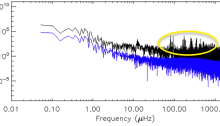Abstract
The NASA Kepler mission has observed more than 190,000 stars in the constellations of Cygnus and Lyra. Around 4 years of almost continuous ultra high-precision photometry have been obtained reaching a duty cycle higher than 90% for many of these stars. However, almost regular gaps due to nominal operations are present in the light curves at different time scales. In this paper we want to highlight the impact of those regular gaps in asteroseismic analyses and we try to find a method that minimizes their effect in the frequency domain. To do so, we isolate the two main time scales of quasi regular gaps in the data. We then interpolate the gaps and we compare the power density spectra of four different stars: two red giants at different stages of their evolution, a young F-type star, and a classical pulsator in the instability strip. The spectra obtained after filling the gaps in the selected solar-like stars show a net reduction in the overall background level, as well as a change in the background parameters. The inferred convective properties could change as much as 200% in the selected example, introducing a bias in the p-mode frequency of maximum power. When global asteroseismic scaling relations are used, this bias can lead up to a variation in the surface gravity of 0.05 dex. Finally, the oscillation spectrum in the classical pulsator is cleaner compared to the original one.


